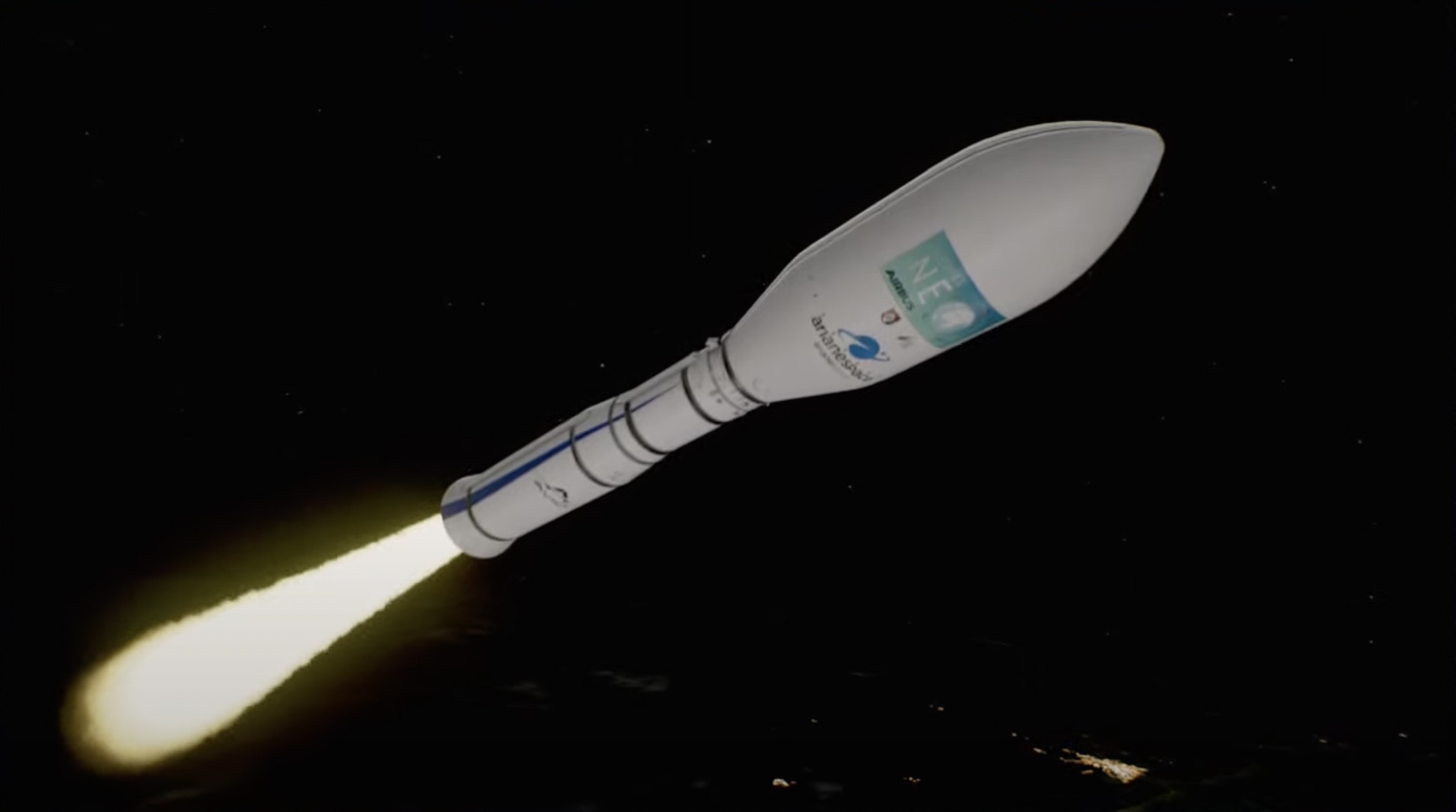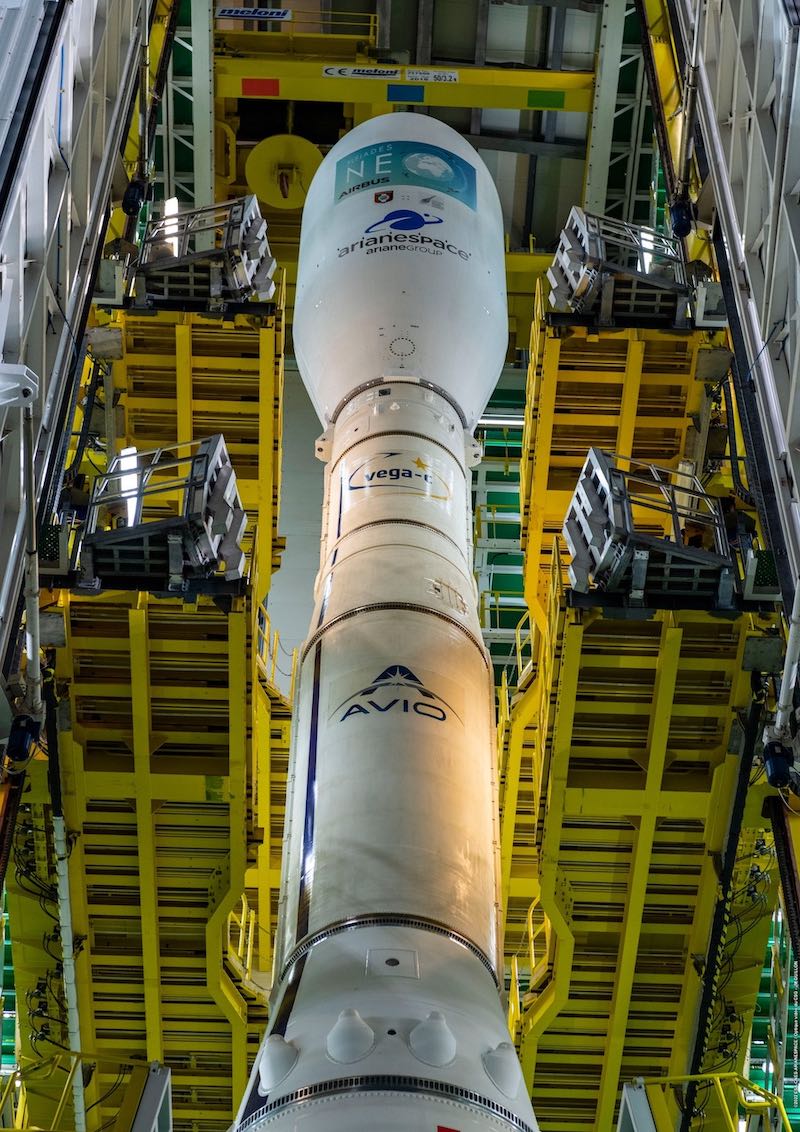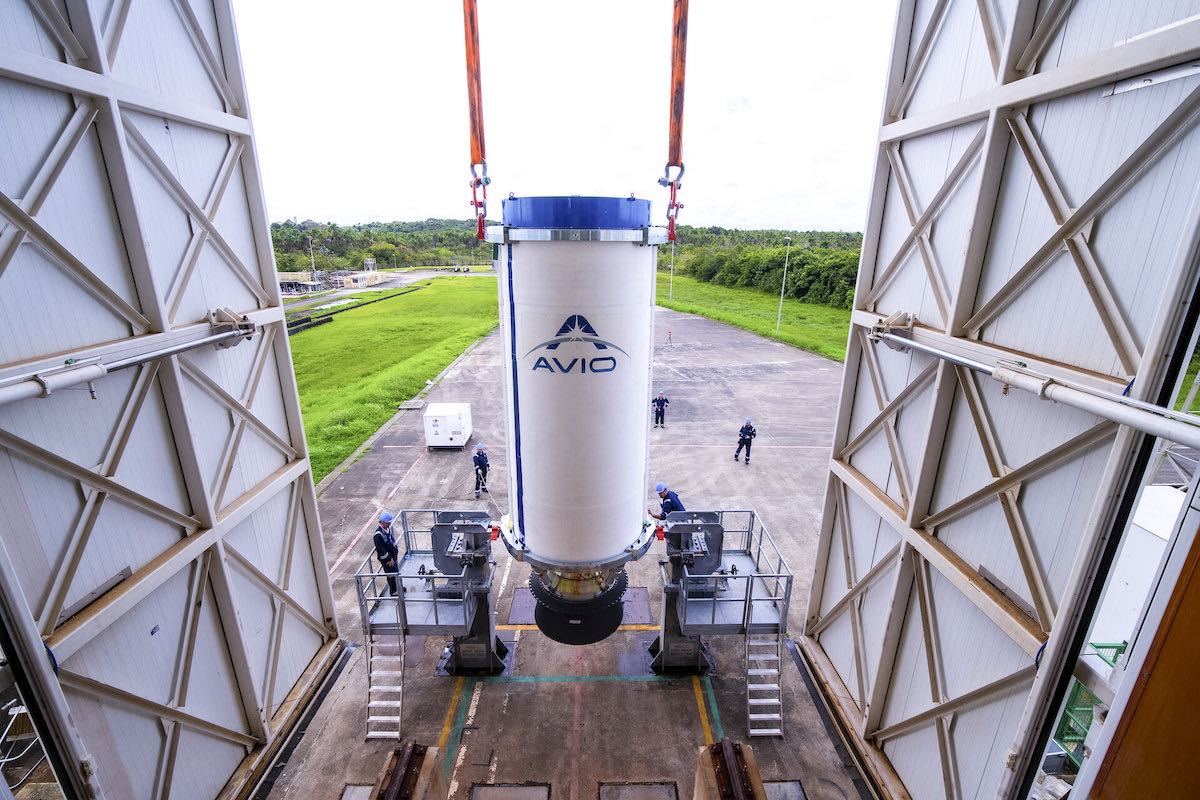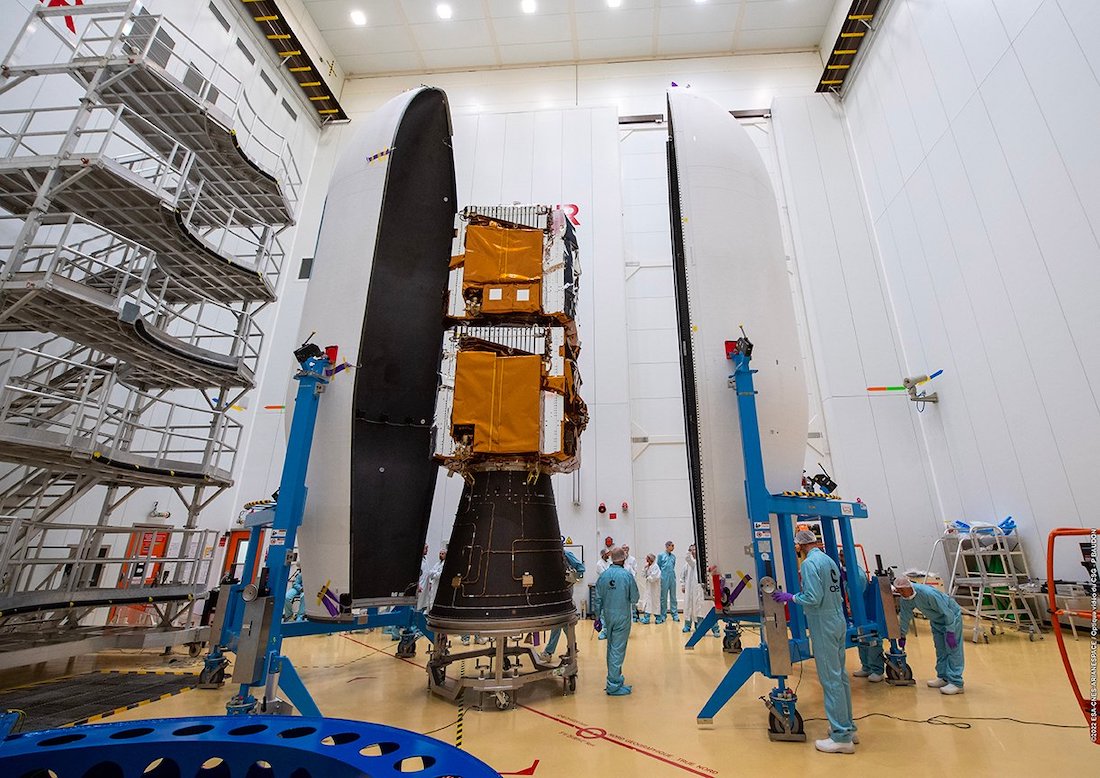
The final two spacecraft in Airbus’s four-satellite, 600 million-euro commercial Pléiades Neo Earth observation fleet crashed into the Atlantic Ocean shortly after launch Tuesday night, falling victim to a failure of a European Vega C rocket shortly after liftoff from French Guiana.
The Vega C rocket’s launch operator, Arianespace, confirmed the mission failed to place the two Pléiades Neo optical imaging satellites into orbit. The preliminary focus of the failure investigation centered on the Vega C rocket’s second stage.
The 114-foot-tall (34.8-meter) rocket lifted off from the Guiana Space Center at 8:47:31 p.m. EST Tuesday (0147:31 GMT Wednesday) with the Pléiades Neo 5 and 6 Earth-imaging satellites for Airbus Defense and Space. The target was a polar sun-synchronous orbit.
The Vega C’s powerful solid-fueled P120C first stage booster burned nearly two-and-a-half minutes, producing a million pounds of thrust to accelerate the rocket into the upper atmosphere. Heading north from the South American coastline, the rocket shed its spent first stage motor casing and fired a second stage Zefiro 40 motor to continue the climb into space.
Liftoff of Europe’s Vega C rocket on its first operational mission from the Guiana Space Center, carrying two sharp-eyed Pléiades Neo optical Earth-imaging satellites into polar orbit for Airbus. https://t.co/rUACF3jhhj pic.twitter.com/X1NZwlb8mh
— Spaceflight Now (@SpaceflightNow) December 21, 2022
But Arianespace said in a press release that the rocket ran into trouble about 2 minutes and 27 seconds after liftoff, near the start of the Zefiro 40 motor firing.
“After the liftoff and the nominal ignition of P120C, which is the first stage of the Vega, an underpressure has been observed on the Zefiro 40, which is the second stage of the Vega,” said Stéphane Israël, Arianespace’s CEO. “And after this underpressure, we have observed a deviation of the trajectory and a very strong anomaly. Unfortunately, we can say that the mission is lost.”
Telemetry from the rocket showed the vehicle losing velocity about three-and-a-half minutes into the flight, when the Zefiro 40 motor should have been propelling the Vega C to faster speeds. The rocket appeared to reach a peak altitude of about 360,000 feet, or 110 kilometers. Tracking data indicated the rocket re-entered the atmosphere over the Atlantic Ocean, with the final measurement showing the Vega C about 570 miles (917 kilometers) north of the spaceport before it likely disintegrated from heating and aerodynamic forces.
“I want to deeply apologize to our customer, Pléiades Neo and Airbus Defense and Space, for this failure tonight,” Israël said. “And we will now have to work with all our partners to better understand why the Zefiro 40 has not worked properly tonight, triggering the failure of the mission.”

The Zefiro 40 second stage, like the Vega C’s other solid-fueled booster stages, is produced by the rocket’s prime contractor, the Italian aerospace company Avio. The second stage motor is designed to burn its supply of 40 tons (36 metric tons) of pre-packed solid propellant in about 90 seconds.
The launch Tuesday night was the first commercial flight of Europe’s upgraded Vega C rocket, following the Vega C’s flawless inaugural test flight July 13.
The Vega C rocket replaces the old Vega rocket’s solid-fueled first and second stages with wider, heavier motor casings. The third stage motor is unchanged, and the restartable liquid-fueled fourth stage has the same type of engine but carries more propellant. The upgraded Vega C is taller than the original Vega rocket configuration, and has a larger payload fairing provided by the Swiss company Beyond Gravity, formerly known as RUAG Space.
The wider Zefiro 40 second stage on the Vega C rocket replaces the Zefiro 23 motor on the basic model of the Vega rocket, adding 50% more solid propellant and generating 293,000 pounds of thrust.
Here's the statement from Stéphane Israël, Arianespace's CEO, confirming an "underpressure" was detected on the Vega C rocket's second stage Zefiro 40 motor, causing the failure of tonight's launch with Airbus's Pléiades Neo 5 and 6 satellites. https://t.co/rUACF3jhhj pic.twitter.com/9gGdpJs9OV
— Spaceflight Now (@SpaceflightNow) December 21, 2022
Europe’s Vega rocket family has now suffered three failures in 22 flights. The three failures have occurred on the Vega rocket’s last eight launches, following 14 straight successful flights since the Vega launcher entered service in 2012.
Investigators blamed a 2019 launch mishap on a “thermo-structural failure” on the Vega rocket’s Zefiro 23 second stage. A 2020 launch failure was traced to misplaced cables on the Vega rocket’s liquid-fueled upper stage, called the Attitude and Vernier Upper Module.
The Vega rocket had amassed four straight successful launches, including the debut of the Vega C, before Tuesday night’s doomed mission.
The satellites lost on the Vega C rocket were the third and fourth spacecraft in a quartet of Airbus-built and -owned Earth observation satellites. The first two Pléiades Neo satellites launched in 2021 on separate Vega rockets, but Airbus put the third and fourth spacecraft of the constellation on the same mission to take advantage of the Vega C rocket’s heavier carrying capacity.

ESA-Manuel Pedoussaut
The Pléiades Neo satellites feature improvements over Airbus’s two first-generation Pléiades Earth observation satellites launched in 2011 and 2012. Airbus says it entirely funded the development of the Pléiades Neo satellites, with intentions to sell the imagery commercially to private companies and government users. The company announced the Pléiades Neo program in 2016, and Airbus assembled the Pléiades Neo spacecraft at its facility in Toulouse, France.
The four-satellite program was expected to cost Airbus about 600 million euros, or roughly $700 million.
The Pléiades Neo satellites can produce optical imagery of Earth’s surface with a resolution of 11.8 inches, or 30 centimeters, according to Airbus. That’s good enough to resolve features such as vehicles and road markings. The first two Pléiades satellites launched more than a decade ago have 19.6-inch, or 50-centimeter, resolution.
Airbus has released imagery from the first two Pléiades Neo satellites showcasing their capabilities, picturing lava flows from volcanic eruptions, large-scale music and sports events, and views of aircraft and rockets at airports and spaceports.
The imaging resolution of Airbus’s four Pléiades Neo satellites is comparable to the resolution provided by Maxar’s six-satellite WorldView Legion surveillance satellites due to begin launching next year. The companies are competitors, providing the highest-resolution Earth observation imagery on the global commercial market.
With the help of laser inter-satellite communications links, the Pléiades Neo satellites will be able to respond rapidly to tasking requests within a half-hour, according to Airbus.
A single Pléiades Neo satellite, using a new agile pointing capability enabled by control moment gyroscopes, can turn side-to-side to observe the same location every two days. Once all four satellites are in orbit, the constellation will be able to image any location on Earth twice a day.
Each Pléiades Neo spacecraft is designed to operate for at least 10 years. One Pléiades Neo satellite can collect images covering an area of nearly 200,000 square miles (500,000 square kilometers) every day, Airbus says.

The applications for Pléiades Neo imagery include urban planning and city management, climate change assessments, and determining the impacts of pollution. The satellites can also be tasked to assess the damage from natural disasters, and the imagery also has military applications.
The Vega C rocket aimed to deploy the Pléiades Neo 5 and 6 satellites into a polar, or north-south, orbit about 385 miles (620 kilometers) above Earth.
Europe’s Vega rocket family is designed to carry small to medium-size satellites into orbit. Developed in partnership between Avio and the European Space Agency, the upgraded Vega C rocket is capable of hauling up to 5,070 pounds (2.3 metric tons) of payload mass to a 435-mile-high (700-kilometer) polar orbit, an increase over the 3,300-pound (1.5-metric ton) capacity of the basic model of the Vega rocket.
ESA and the European Commission reached an agreement with Arianespace last month to launch five satellites for Europe’s Copernicus Earth observing system on Vega C rockets. The new deal increased Arianespace’s backlog to 15 Vega missions, including 13 Vega C missions and two more launches with the original Vega rocket configuration.
Email the author.
Follow Stephen Clark on Twitter: @StephenClark1.
from Spaceflight Now https://ift.tt/3YXmUMW
via World Space Info







0 comments:
Post a Comment